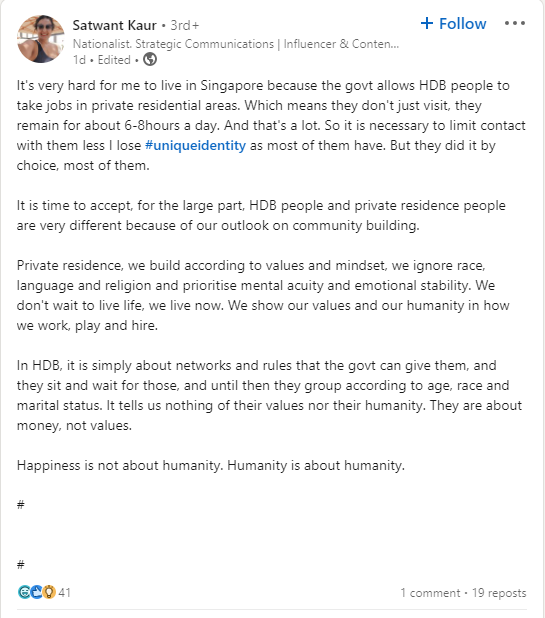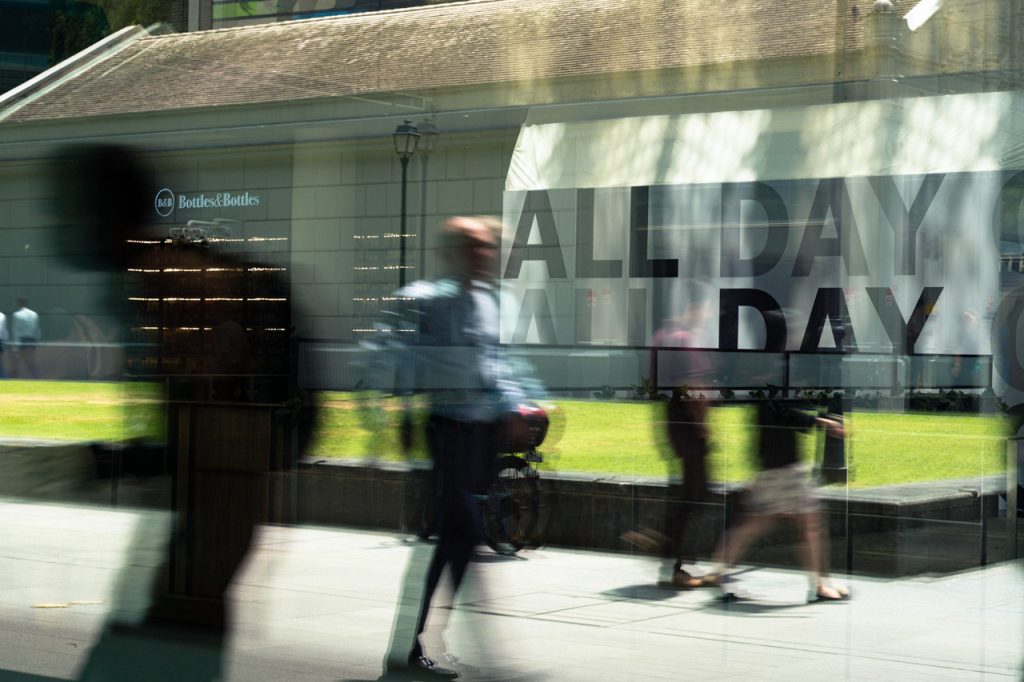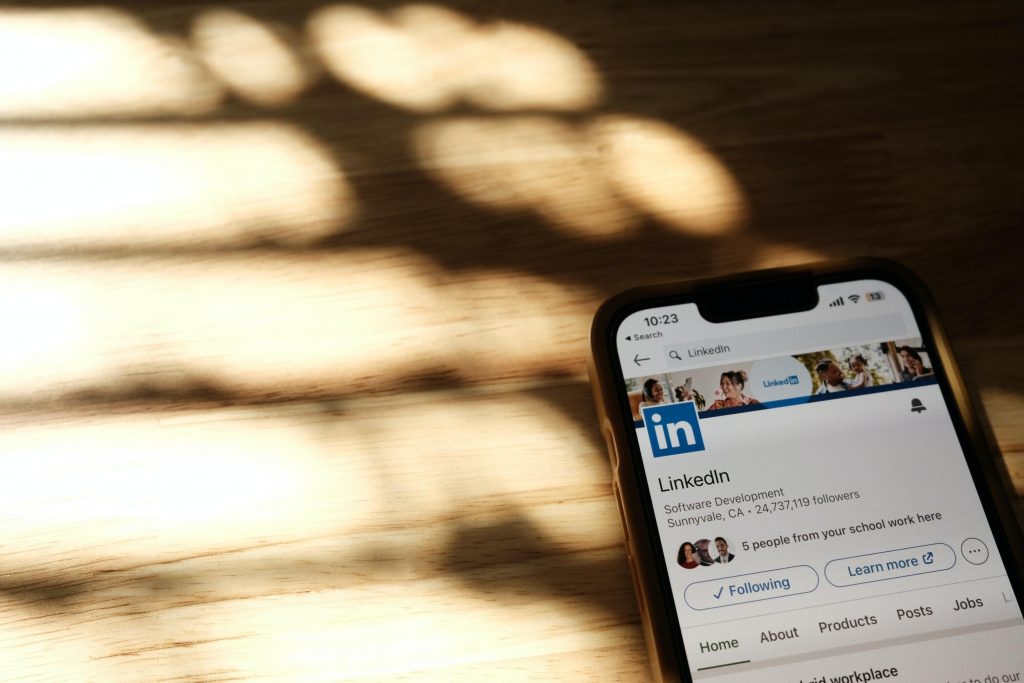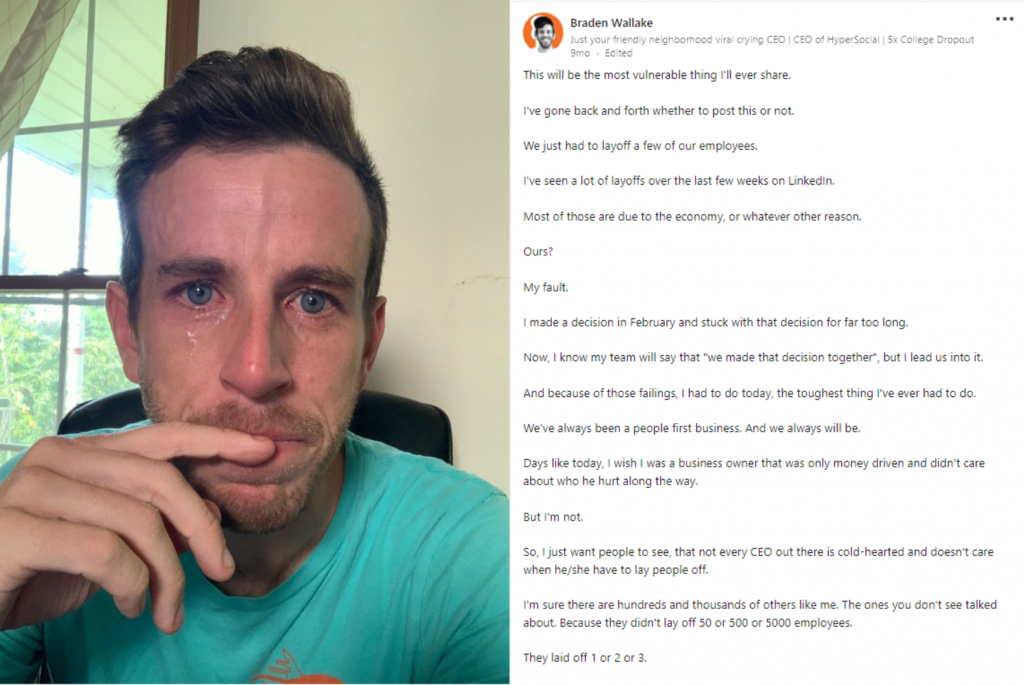Top Image: Bastian Riccardi / Pexels
LinkedIn influencers love to use euphemisms and buzzwords. So it’s extra weird when someone goes LinkedIn mode with a frightfully bigoted opinion.
As a professional corporate platform, the buzzwords come aren’t surprising. The corporate world is no stranger to jargon (downsizing = retrenchment; being in between jobs = unemployed).
In the context of such a platform, where everything is staked on how well you sell yourself, bad takes on social issues take on a heightened level of jeopardy. Especially when it’s backed up with professional achievements and educational accolades.
Yesterday, a Ms Satwant Kaur published a post on LinkedIn that has since gone viral for drawing a line between “HDB people” and “private residence people”.
Kaur bemoaned the “HDB people” taking jobs in private residential areas and claimed they were “about money, not values”. She also said she had to keep a distance from them lest she lose her “#uniqueidentity”. Whatever that is.

While drawing flak across platforms, the author of the post flared up to a response on LinkedIn made by a university student, Nadine. The latter typed out a long, thoughtful rebuke, tagging Kaur to ask for clarifications for the statements she made in the original post in addition to even older, inflammatory posts she had made.
Others intervened, replying to agree with or defend Nadine in the comments section.
But Kaur has refused to explain further, declaring that the student was not “owed an explanation”.
Everyone’s a Thought Leader
That’s the trouble with posting hot takes and unpopular opinions on LinkedIn. Unlike other platforms, LinkedIn is specifically a professional platform. Supposedly, anyway.
It becomes tougher to discredit an opinion when the one who wrote it isn’t a boomer-y auntie or uncle on Facebook. Or anonymous, faceless Redditors.
LinkedIn users are mostly highly educated, white-collar workers who use the platform in a professional capacity.

They have their education and past work experience on display, and all these add up to the power of their ethos and credibility. And this power is granted to anybody aspiring to be a thought leader and share their takes, however controversial.
Here’s an example. Harsimarbir Singh, the co-founder of a health-tech company Pristyn Care, posted on LinkedIn a list of interview hacks that he subjects applicants to. Some of these ‘hacks’ were simply disrespectful to their interviewees’ time, for example, asking them to stay for six to eight hours in the office to test their patience and regularly holding Sunday interviews to test their “extraordinary commitment”.
This was met with much backlash. But there is no doubt about the danger that someone with his reputation as a successful business owner could so easily influence others.
It should be no surprise. There is an entire culture of horrible takes on the business-minded platform—so much so that there’s a subreddit and Twitter accounts dedicated to insufferable LinkedIn content.
All About Packaging
LinkedIn posts are typically packaged with flashy buzzwords and a distinct voice, one that sounds inspirational and grandiose. Creators intentionally use language that pulls at your heartstrings, hoping that it’ll distract you from a possible lack of substance.

In Kaur’s post, she spun a message that was meticulously crafted. She used buzzwords and vague terms, which upon further examination, doesn’t make much sense.
She provides no clear reason why people who stay in private residences are able to prioritise mental acuity (which is just a fancy way of saying intelligence) and emotional stability. Or why HDB dwellers don’t have values. Or what kind of “networks and rules” she talks about.
But hey, “humanity is about humanity”, right?
Main Character Syndrome
On LinkedIn, anything and everything you experience can be a learning lesson—and an opportunity to pat yourself on the back and (attempt to) score clout.
Maybe it’s virtue-signalling for validation, a lack of self-awareness, or both. But it often culminates in out-of-touch content, such as the CEO who posted a crying selfie after laying off two employees.
In a way, it’s understandable. It’s drilled into our heads to sell ourselves in resumes and job interviews. Why wouldn’t you do the same on LinkedIn?

If you look past the jabs at “HDB people” in Kaur’s post, the aggrandisement becomes obvious. While “HDB people” are all about money, Kaur expresses higher-order interests: Humanity, mental acuity, community, and emotional stability. Could someone please give the woman a trophy or a LinkedIn Top Voices badge?
But the tendency for self-praise on the platform isn’t exclusive to Kaur.
Tom Orbach, the creator of an artificial intelligence tool that generates viral LinkedIn posts of customisable cringe levels, says the platform’s most successful posts have one thing in common. They’re all “self-centred, even a bit narcissistic”.
Where Passive Aggressiveness Thrives
Another LinkedIn quirk is the oddly formal and stilted language. A quick scroll through, and you’ll see lots of “kudos” and people who are “pleased to announce” that they are “humbled” by some new fluffed-up accolade. And don’t forget to congratulate that acquaintance on their work anniversary.
In the same way that “as per my last email” is akin to flipping someone off in the corporate world, LinkedIn disagreements are masterclasses in passive aggression.

Highlights of the debate include Kaur refusing to explain herself—she insists that her opponent did not “live on the same part of the bell-shaped curve”. Nadine attempted to wrap things up with ”Let me know when we can continue our discussion. I wish you well.”
Things quickly devolved into name-calling, though, with Nadine labelling Kaur a “bigot” and Kaur hitting back by calling her an “ignoramus”.
We guess they won’t be circling back to the original topic soon.
Beyond the LinkedIn Bios
It goes without saying that there’s no appropriate platform for elitist and classist takes.
But on a website where narcissistic posts thrive and humble bragging is the name of the game, we’re not surprised that Kaur thought her little essay would strike a chord.
Her post did garner some support (for some reason). But it’s heartening to know that others like Nadine are taking a firm, public stand against her sentiments in their reposts.
LinkedIn does have its own pros and can be a trove for networking and career advice. But when content is highly packaged and anyone can make themselves look like experts, it becomes more important to be able to weed out the duds.
After all, there’s a difference between plain old cringeworthy posts and harmful rhetoric. Perhaps the only consolation is that the internet never forgets, and Kaur’s hot takes are preserved in full posterity for any of her future employers and employees.






